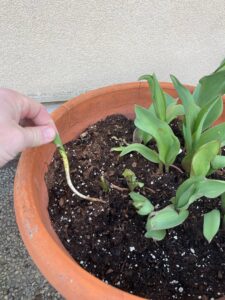
Well, isn’t this just the saddest thing? You spent all that time last fall, carefully picking out your tulip bulbs and dreaming of the pop of color they’d bring to your garden come spring. But when you went out to check on them recently, those lovely blooms were nowhere to be found! Don’t feel bad, growing tulips is tricky! Whether the greenery is sparse or totally absent, I know how disappointing it is when our tulips don’t perform like we hoped.
But don’t go pulling out your trowel just yet! There are a few usual suspects that could be standing between you and your dream tulip garden. With a little investigating and good old-fashioned tender loving care, we can get to the bottom of what’s keeping those gorgeous flowers from unfurling.
Watering
Now, the first culprit could simply be too much or too little agua for our thirsty bulbs. Tulips need just the right amount of hydration when pushing up those stems and leaves. Too dry and they’ll have a hard time breaking through. But overly soggy soil can rot them from the get-go. Around an inch of water weekly from rain or your watering can is just about perfect. And those bulbs fare best in that loose, well-draining soil we all love.
Animals
Another common issue? Four-legged flower bandits enjoying an early spring feast! If those tulips are just disappearing into thin air, you might have some hungry bunnies, deer, or squirrels calling your garden the new hot brunch spot. (See our last newsletter for a lengthy commiseration on critters). A few spritzes from a jalapeno-infused spray usually persuades them to take their nibbles elsewhere. Crushed eggshells, mesh coverings, and some discreet fencing can also help shoo away those varmints.

Now let’s talk about those spotty patches of tulips that just never quite color up or bolt up with gusto. If you’re seeing stunted yellowish growth, twisted stems, or holes in the greenery, fungus or some other plant disease might be afoot. Poorly draining soil can really spread that kind of blight. As heartbreaking as it is, it’s best to just dig out any sickly bulbs and start fresh next year with some good, resistant varieties and nutrient-rich soil.
Sunlight
Of course, it’s also possible our tulips are getting a little too shaded from the elements. They need at least 6 hours of direct sunshine daily to put on that gorgeous springtime show. If yours are in a dimmer corner, those leaves may still flourish, but you’ll likely miss out on the burst of color. Take note of those duller areas and consider moving future bulbs somewhere sunnier.
Planting
When all else fails, pay close attention to how you’re putting those bulbs to bed each fall. They like a nice, fluffy 4-6 inch blanket of nutrient-rich soil. And be sure not to rough them up too much during planting – those tender bulbs are fragile things. It’s also possible those first balmy days of early spring tricked them into sprouting prematurely, only to get zapped by another cold snap.

Ok, that’s a lot of what you might do differently when you plant in the fall, but let’s talk about what you can do now. To be absolutely clear there’s not MUCH but I’m a firm believer in doing what CAN be done in the HOPES it will move the bloom needle in my favor.
- Increase the airflow around the base of your tulips by removing any dead leaves or other non-tulip material that may have blown in there. Airflow is key to reducing the fungus (botritis) that makes your tulips look like they’ve been torched (thus the term “Tulip Fire” and “Fire heads”). If your tulip looks torched, yank it and remove it from the field (don’t compost where the spores may work their way back to the healthy flowers).
- Consider a low hoop system over top of your tulips to keep the critters off and increase the heat to the bulb, thus speeding up the bloom cycle. You’ll want to keep track of moisture UNDER the tenting because humidity is NOT kind to tulips but if you’re looking to spark some color for, say Easter Weekend, captured heat is about the only way to cue an earlier than “normal” bloom.
Now is the time for a little detective work, so you can get to the bottom of why tulips failed to bloom this season. Give them another try in the fall, following best planting practices and providing ample sun, water, and protection from hungry pests.
Tulips may seem fussy, but with a little wisdom and care, we can get them back on track. So let’s get out there and rescue those spring beauties! With the right conditions and a little patience, you’ll be rewarded with armloads of vibrant blooms to welcome the new season.








